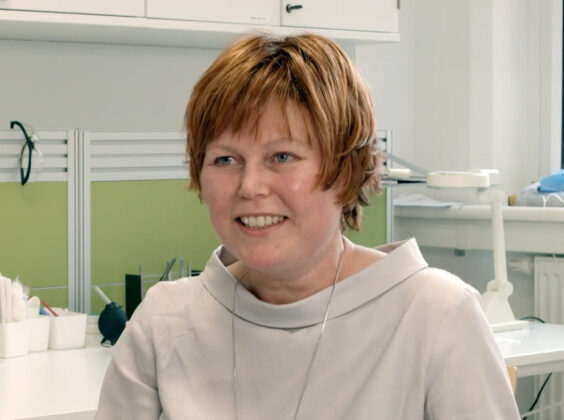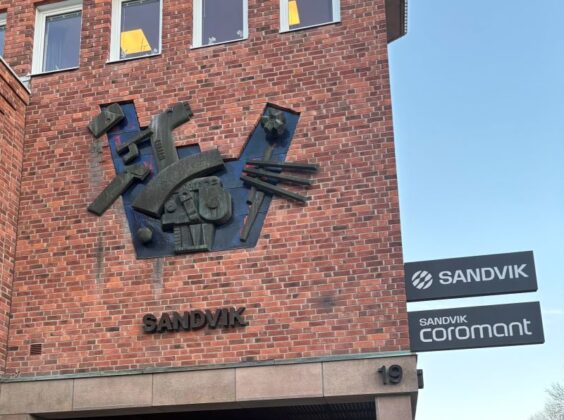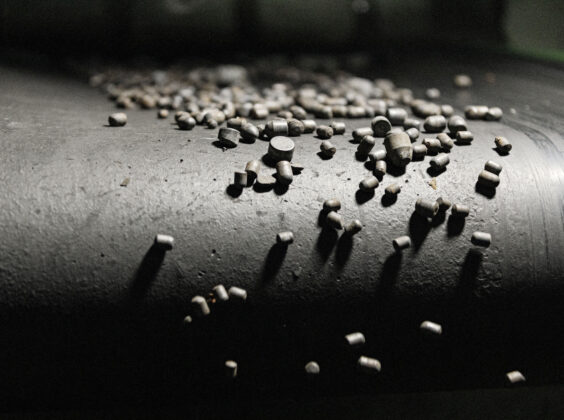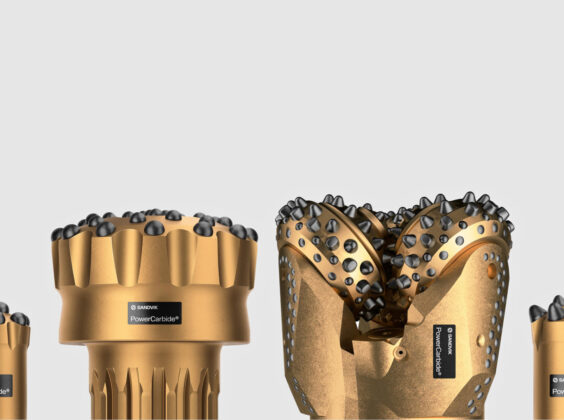Cemented carbide is at the heart of rock tools technology, and IM Editorial Director Paul Moore recently had the chance to visit Sandvik’s state of the art carbide facility in Västberga, southwest of Stockholm, which is a hub for rock tools carbide inserts production but also serves as Sandvik’s global R&D centre for carbide technology.
Sandvik retains a whole block of the industrial complex and has been present there since 1954 when the carbide factory was first opened. Sandvik Coromant – the tooling specialist, also has its R&D facilities on the site and in total about 150 material researchers and technicians work here to develop new hard and superhard materials and processes for both rock drilling and metal cutting using state of the art equipment and instruments IM met with Malin Martensson, Expert at Rock Tools R&D along with Annika Kaar, R&D Manager Hard Materials.
Annika Kaar, R&D Manager Hard Materials, Sandvik

The site is unique in that Sandvik rock tools carbide development and production are located next to each other – on the same floor. Kaar commented: “We are very well equipped as in addition to the inserts production we have our own lab and prototyping facility. We can then test these prototypes in various ways. Most of our engineers have a PhD in subjects such as materials science, chemistry and physics, plus we have a dedicated team of technicians as well.”
#Sandvik’s Malin Martensson, Expert at Rock Tools R&D

She adds: “There are many steps involved in developing a cemented carbide. First, we can look at the chemistry of the material itself and model different compounds to see what might have potential in composition, sintering temperature etc. We make the carbide powders and develop the processes ourselves. We can then make the inserts itself and analyse sections of it for structure using SEM and other methods including those used to assess its mechanical properties. We work with the production facility on the manufacturing processes as well – as the material gets its properties both from the material composition as well as the process parameters such as sintering temperature and pressure.”
The R&D team also plays a very active role in field tests of rock tools equipped with new carbide grades – visiting customers to assess performance; plus of course when any new products are commercially launched working alongside with the product line and marketing team. “Everything we do we also protect with patents – as a global leader in carbide technology this is a really important part of what we do, to protect the innovation behind our unique solutions and processes.”
Martensson explained that while the drill bits themselves often get a lot of the attention – it is the cemented carbide inserts that meet and crush the rock, and the quality and performance of inserts are of most importance for a reliable drilling operation. Sandvik has the broadest offering of carbide grades on the market today. Cemented carbide is a composite material and the general structure consists of hard tungsten carbide (WC) particles forming a continuous ‘skeleton’ with a metallic cobalt (Co) binder filling the residual spacings in-between gluing the material together. While the cemented carbide material itself has been around for over 100 years, with the first patents filed in 1923, there are still many things Sandvik can do to continuously enhance and improve performance.
Sandvik’s has had a state of the art carbide facility in Västberga since the 1950s

She told IM: “By selecting the appropriate combination of hard phases, metallic binder phase and processing parameters, a wide combination of microstructures with a variety of mechanical properties can be achieved. It is a composite material – you have the toughness of the metallic binder, along with the wear resistance from the carbide and by making changes in the chemistry and microstructure desired properties can be achieved.”
Within Sandvik and Rock Tools there are also capabilities in both manufacturing and development of diamond or Poly Crystalline Diamond (PCD) bits.
Kaar and Martensson outlined the production of cemented carbide products, which is a complex powder metallurgical process involving many processing steps, such as raw powder production, mixing and milling, spray drying to produce granulates, followed by pressing, extruding or moulding into a soft green body having the desired shape. Densification of the green bodies into blanks involves debinding and liquid phase binding sintering. The final insert or button is obtained after several post-sintering treatments, such as grinding and other finishing operations, which significantly increase the strength of the carbide insert.
Up to 75% recycled material is used in most Sandvik PowerCarbide® grades

Interestingly the shape of pressed and sintered inserts looks the same – but with the important difference that the sintered inserts have about 50% less volume when it is sintered to full density. This shrinkage is a similar effect as seen when firing ceramics and is very important in providing structural strength and hardness.
All manufacturing processes are linked, meaning that any change in any manufacturing step in the production chain will influence the subsequent process and the quality of the final product. Sandvik is well-known for high performing cemented carbide products and rock tools and at all Sandvik’s production sites the quality control and tight tolerances are of most importance in every pjroduction step.
PowerCarbide® options are now available for top hammer, down-the-hole, rotary and mechanical cutting rock tools

Martensson: “Depending on the application, the carbides have distinct formulations – for top hammer and down-the-hole, you typically have quite small tungsten carbide grains with tight spacing, while for rotary you need larger grains and also more metallic binder to provide more toughness. Then once you get into mechanical cutting, we use very large tungsten carbide grains. It is always a trade-off between wear resistance and toughness – if you want to increase wear resistance – primarily abrasion resistance – usually the toughness as crack resistance that goes down. With our premium PowerCarbide® grades, we have been able to challenge this trade-off and achieve an increase in both the toughness and wear resistance, by optimizing various properties as well as the manufacturing processes.”
This is unique to Sandvik and is a result of material and process design including solution hardening, mass transfer and reaction sintering. Sandvik has shown that PowerCarbide® can reduce the amount of insert breakages by between 50-70% depending on the application. At the same time, you get a wear resistance increase which translates to drill bit longevity.
Beyond that, what Sandvik likes to call the PowerCarbide® toolbox, is the combination of new processes and material technology platforms, that allows it to pick and choose inserts for specific customer applications. None of Sandvik’s competitors have any of these materials, so they are unique in the market and only available in Sandvik bits. For customers they change bits less often, so they get better economy of drilling plus it is more sustainable. It also increases safety as changing bits manually comes with risk. In some cases, PowerCarbide® means that the bits will last for a whole drill pattern resulting in that bit changes can be done away from the face before the next pattern, in a much safer place.
The grades within the toolbox – Self-Hardening (SH), Gradient Carbide (GC), Dual Property® (DP®) and XT – offer unique combinations of strength, hardness, toughness and wear resistance to optimise customer drilling applications. PowerCarbide® options are now available for top hammer, down-the-hole, rotary and mechanical cutting rock tools with the specific grades including, GC81, GC85, SH69, SH70, SH75, XT49, DP®55, DP®65, XT90 and XT70. The geometry of the inserts varies as well – some are more rounded and some more pointed, depending on the application – this development is done together with the drill bit design teams.
GC81 and GC85 was developed for hard and abrasive ground conditions in top hammer and rotary drilling. Innovative manufacturing processes make it possible to produce inserts that are wear-resistant on the outside, while the centre provides a toughness that further extends service life. In top hammer GC81 has proven excellent performance in all types of abrasive rock, both surface and underground.
SH69 for DTH, SH70 for top hammer and SH75 for rotary and raise boring are grades with homogeneous properties throughout the material. It is ‘self-hardening’ as it has the ability to become both more wear resistant and tougher as drilling progresses. This is due to enhanced deformation hardening. The surface hardness is continuously ‘refilled’ which means that the hard top recreates during drilling. The hardening effect is greatest in hard and competent ground, and it works very well in pointy geometries with large protrusion as in Speedy bit and Autobit for top hammer applications.
XT49 takes the standard straight grade, XT48, to the next level. The manufacturing process enables the reduction of early breakages of the insert. As this grade is more resilient to breakage, it enables more protrusion and a sharper geometry.
The DP®-grades, DP®55 and DP®65, were introduced in the 80’s and are still the optimum choice in some applications, even if they have been and are successfully being replaced by the newer PowerCarbide® concepts, GC and SH at most customers.
The XT70 is a grade perfect for cutting in hard and abrasive rock and offers the best high temperature wear resistance of all cemented carbide grades for longest pick wear life. The XT90 works at its best in hard to very hard but less abrasive minerals. It is also a snakeskin stopper and is the toughest cutting grade.
Finally, a note on circularity – also unique is that Sandvik controls the entire process from mine to final insert and drill bit – starting with scheelite tungsten ore mining at its Wolfram Bergbau und Hütten AG in Austria. At the other end of the scale, it has advanced recycling units for tungsten carbide, both in regional hubs in major mining areas as well as at customer sites, and a growing proportion of Sandvik’s insert production is based on recycled material which reduces the amount of virgin ore having to be mined.
“We work a lot with how to use circularity in a smart way – to be as sustainable as possible for example using recycled inserts but never at the expense of product performance. Recently, Sandvik introduced up to 75% recycled material in most of its PowerCarbide® grades, giving a large decrease to an already low carbon footprint, still with same or even improved performance proven in field tests,” said Kaar.




